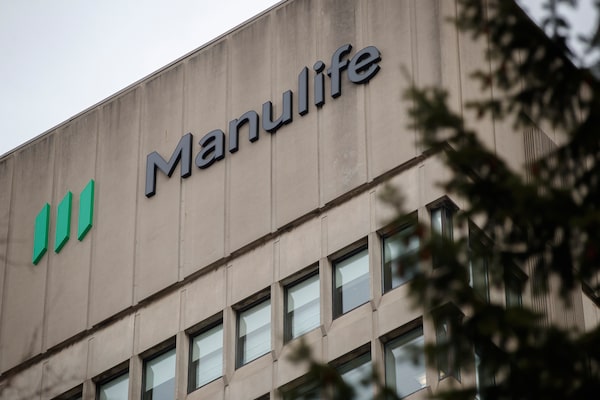
A Manulife Financial office in Toronto, on Feb. 11, 2020.Cole Burston/The Canadian Press
Some pharmacare policy experts are raising concerns about competition and patient access to much-needed medication after Manulife Financial Corp. MFC-T announced its coverage of certain prescription drugs will only apply at Loblaw Cos. Ltd. L-T pharmacies.
The new arrangement, details of which were shared with plan holders earlier this month, affects around 260 medications under the insurance company’s Specialty Drug Care program. Drugs in this class are meant to treat complex, chronic or life-threatening conditions such as rheumatoid arthritis, Crohn’s, multiple sclerosis, pulmonary arterial hypertension, cancer, osteoporosis and hepatitis C.
Manulife said that starting Jan. 22, the program would transition to being carried out “primarily” through Shoppers Drug Mart and other Loblaw-owned pharmacies. The company had previously also covered specialty drugs through national home and community health-care providerBayshore HealthCare.
“At this time, to evolve our program, it’s appropriate to select a single service provider to move the program forward for the benefit of our customers and their employees,” said Doug Bryce, Manulife vice-president of product and platforms, in the announcement.
Such deals that provide exclusivity, known as preferred pharmacy network arrangements, are common in the U.S. and growing in Canada, said Steve Morgan, an economist and professor of health policy at the University of British Columbia.
“It is a means of insurers exercising market power in the pharmacy sector,” said Morgan, who studies pharmacare systems, in an e-mail.
“This is a concern for smaller pharmacies, who will get squeezed by these practices as they extend beyond specialty medicines It is also of potential concern to patients who might have fewer options for their medicines.”
The significant markups charged by pharmacies for specialty drugs can play a key role in “shadowy” agreements with insurance companies, said Marc-Andre Gagnon, a professor at Carleton University whose focus is on social, health and pharmaceutical policy. He noted those drugs are already on the higher end in terms of cost.
“There’s a lot of money for these specific drugs, which means there’s a lot of leeway to organize a system of rebates between the drug manufacturer, the patient support programs, the insurer and the pharmacies,” he said.
“You end up with these very shady deals that are completely under the table, basically, in a system where there’s no transparency and we just don’t know anything about what’s going on.”
He said this has negative implications for both competition and patient access, especially for those who live in rural or remote regions “who might not have the same easy access to all the different pharmacy chains.”
“You will end up with smaller players that will be basically pushed out of the market because they will not be able to compete, because they don’t have access to the same sources of revenues,” said Gagnon.
In a statement, Manulife spokeswoman Emily Vear said the deal with Loblaw will provide “more options” for group benefits members to receive their specialty medications, with patients able to pick up drugs from a Loblaw-owned store or have them delivered to their home.
“We believe in providing our members greater choice in how they access and receive the services they need for their health and wellness,” she said.
“This exciting partnership also enables access to a dedicated team of expert professionals, such as nurses and pharmacists, to help manage and administer our members’ medications.”
On its website, Bayshore HealthCare says Specialty Drug Care plan members could have their medication shipped to their home, a clinic or doctor’s office, but it does not mention pickup options at pharmacy locations.
Loblaw spokeswoman Catherine Thomas said in a statement that the company is confident that patients’ experience “will remain unchanged, if not better.”
“They can pick up their prescriptions from one of more than 1,800 pharmacies across our network, or have them shipped directly to their home,” she stated.
Other experts dispute the notion that preferred pharmacy network arrangements hurt competition.
“The purpose of Manulife’s strategy is to force pharmacies to compete for its business,” said University of Calgary economics professor Aidan Hollis in an e-mail.
“So that is not anti-competitive: it is the evidence that Manulife is using competition to drive down costs.”
Hollis, whose research focuses on innovation and competition in pharmaceutical markets, said the strategy “is unusual in Canada but not unprecedented.” He pointed to a preferred pharmacy network arrangement for specialty drugs introduced by insurance provider GreenShield in 2015 through HealthForward.
“If anything, it’s competition in action,” said University of Toronto pharmaceutical economics professor Paul Grootendorst.
“Suppose Shoppers was at 80 per cent of the market, you could see it potentially squeezing smaller guys, there might be abuse of dominance, but I don’t see it happening here.”
But he acknowledged pushback against such arrangements, particularly among those who believe every person should have their free choice of pharmacy. Grootendorst said that rationale is why Quebec has outlawed these deals.
On its website, Manulife says exclusive availability of its Specialty Drug Care plan does not apply in Quebec, where “regulations prevent us from offering a preferred pharmacy network.”
Gagnon said this policy makes Quebec an outlier among its fellow provinces. He said the lack of such restrictions elsewhere create an uneven system where some pharmacies attract “all the big money involved with drugs” while smaller ones “struggle to cope.”
“If all the super profitable drugs for pharmacy chains are being captured by just some of the actors, that’s a problem for the rest of the pharmacies,” he said.
“They end up with the leftovers, the drugs that are way less profitable.”